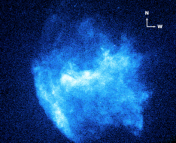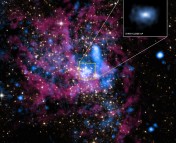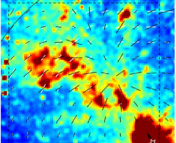Title: NIR Counterparts to ULXs (III): Completing the photometric survey and selected spectroscopic results
Authors: : K. M. López, M. Heida, P. G. Jonker , M. A. P. Torres, T. P. Roberts, D. J. Walton, D.-S. Moon, F. A. Harrison
First Author’s Institution: SRON Netherlands Institute for Space Research, 3584 CA Utrecht, The Netherlands
Status: Published in MNRAS, open access on arXiv
X-ray binaries are systems with a primary that is a compact object like a black hole or neutron star. The compact object accretes material from the companion (the donor star), emitting brightly in X-rays. Outside of our galaxy, some of these X-ray sources have been observed to have luminosities exceeding the Eddington Limit for a stellar-mass black hole (L ~ 1039 ergs/s), we call these sources Ultraluminous X-ray sources (ULXs). There are a few possibilities for the origin of such high luminosities. One explanation is geometry – the Eddington limit assumes that emission occurs isotropically — if emission is actually beamed, then the luminosity is overestimated. Another possibility is if the black hole is actually an intermediate mass black hole accreting below the Eddington limit for its mass (> 100 M☉). In order to understand the nature of these objects, it’s necessary to know their mass.
One way to study these objects is to look at their companion stars. These companions can be anything from a low-mass star to a high-mass star with strong stellar winds. Radial velocity studies of the donor star would result in dynamical mass measurements of the compact object, which is the most reliable way to measure mass.
Many ULXs are found near young star clusters and massive stars evolve fast, so it’s possible that some ULXs have companion stars that have evolved into Red Supergiants (RSGs), making them detectable in the near-infrared (NIR). Today’s paper is the third installment in a series of papers that aim to systematically identify NIR counterparts to ULXs. In this paper, the authors use a sample of 23 previously observed ULXs to look for their companions using NIR imaging, as well as perform spectroscopic follow-up to previously identified NIR counterparts.
Red Supergiant Candidates
To find the NIR counterparts, the authors use NIR images to look for stellar sources within a distance threshold of the known location of the ULX, and with the appropriate magnitude. The authors obtained H-band imaging from LIRIS and SOFI, as well as K-band imaging with WIRC.
Out of the 23 ULXs, 6 of them have a NIR detection, with 2 sources as candidate RSGs. Figure 1 below shows the H-band images for the 2 ULXs with possible RSGs companions: NGC 1313 X-2 and CXOU J112037.3+133429.
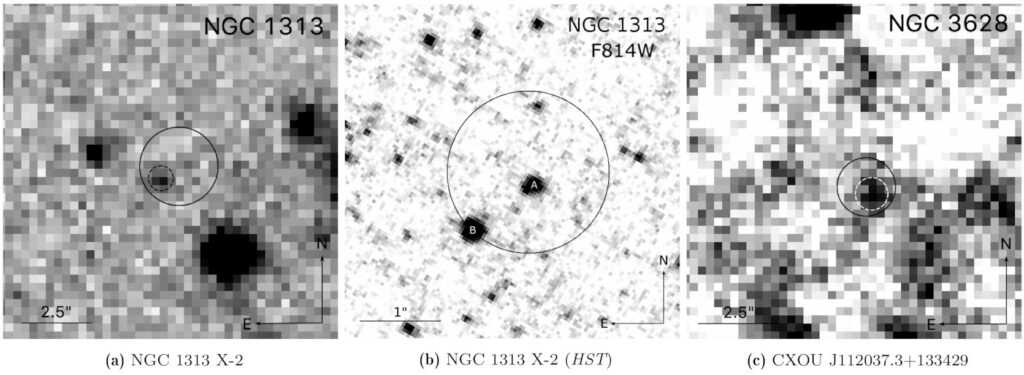
Figure 1: H-Band images of ULX NIR candidate counterparts. The solid circles show the location of the known ULX, the dashed circles show the NIR counterpart. (Top panel of Figure 1 in the paper)
The H-band image of CXOU J112037.3+133429 shows a single source with an H-band absolute magnitude of -9.7, consistent with the expectation for a RSG. On the other hand, for NGC 1313 X-2 — a binary with a neutron star primary — there are multiple stars that could be the companion. The authors find a single source with an H-band absolute magnitude of -7.1, consistent with a faint RSG, but archival HST images show there are actually two sources (labeled A and B in Figure 1, panel b) that could be associated with the ULX. Based on their magnitudes in 3 bands (V, I and J), source A is an O-B star, while source B is also consistent with a faint RSG. It is inconclusive which source is actually the companion in the ULX.
Spectroscopic Follow-up
While photometry is useful for finding potential RSGs, spectroscopy is necessary to confirm the nature of the star. The authors obtained J- and H-band spectroscopy from MOSFIRE to follow up on 5 previously detected ULX counterparts, including 4 candidate RSGs.
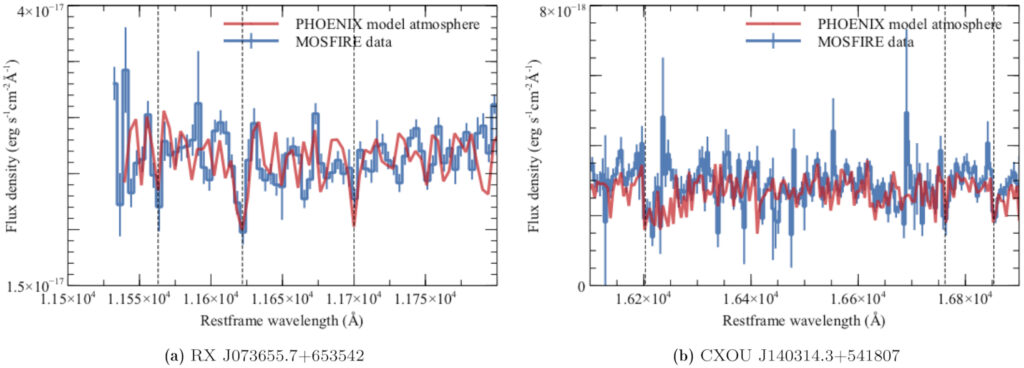
Figure 2: MOSFIRE spectrum for two candidate RSGs. PHOENIX atmospheric models shown in red. The dashed lines indicate strong Fe I absorption lines. (Figure 4 in the paper)
The authors fit the MOSFIRE spectra with stellar atmospheric models of various temperatures, to determine the temperature of the star and therefore its type. For 2 of the candidates (shown in Figure 2), they find temperatures consistent with RSGs (3500-4500 K and 3000-4000 K respectively).
The work presented in today’s paper completes a search for NIR counterparts for over 100 known ULXs. A total of 10 objects have been identified as candidate RSGs using photometry, and a total of 5 have been confirmed as RSGs from spectroscopy — providing the foundation to find masses of the ULX compact object.

